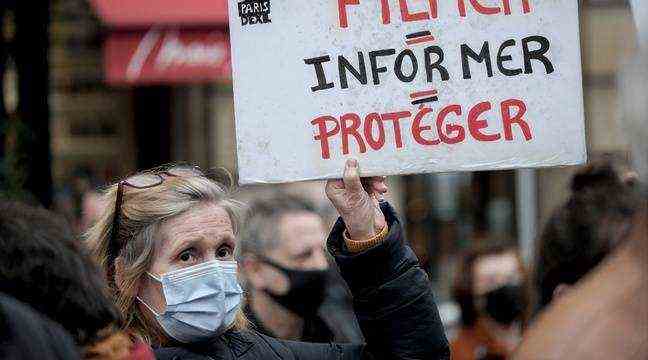A report made Monday to Jean Castex makes 32 recommendations to ease tensions between the two parties, especially around the capture of images. – CELINE BREGAND / SIPA
No accreditation, no obligation to disperse, on the demonstrations, improvement of communication between the media and the police: a report delivered on Monday to Jean Castex made 32 recommendations to ease the tensions between the two parties, in particular around the capture of ‘images.
Noting the deterioration “for at least five years” of relations between the press and the police, in particular during law enforcement operations, the commission chaired by the former controller general of prisons Jean-Marie Delarue pleads for standardization, with an emphasis on the freedom to inform. “The work of the press is subject to increasing and uninhibited obstacles by the police,” she notes for example.
“Renounce any mechanism for accreditation of journalists”
The report is now on the table of the Interior Ministers Gérald Darmanin and Culture Roselyne Bachelot, responsible “to jointly initiate the work that will lead to the implementation of all of these recommendations”, said Matignon, specifying that a “monitoring committee” would also be set up.
In its work, the committee urges “to renounce any mechanism for the accreditation of journalists covering events taking place on public roads”, contrary to what Gérald Darmanin suggested last fall, causing the lifting of harrows. of the profession.
As for the identification of journalists, who will have to ensure “adopting the behavior of observers” in the field, the committee suggests initiating “discussions within the profession” so that the press card, including everyone does not have, is not the only model. In this regard, an “employer certificate” or a special “public order event” card could act as a remedy for journalists.
Guarantee “in all circumstances” the “physical safety of journalists”
Likewise, she asks to “allow journalists who wish to wear protective equipment” on the demonstrations – while these are regularly confiscated from them – and that the “physical safety of journalists” be guaranteed “in all circumstances”. , even if it means being able to “stand behind the cords of the police”.
Another subject of controversy, the commission wishes to assure journalists the “possibility of covering the whole duration of a demonstration”, including when a dispersal has been ordered. Taking advantage of the “new pattern of maintaining order”, Gérald Darmanin had thus justified last November the obligation made to journalists to leave a demonstration.
This commission was originally set up last December to rewrite article 24 of the Global Security bill, which notably provided for punishing the “malicious” use of images by law enforcement officials. But, faced with the outcry and the political crisis between the executive and the Parliament, the government had reoriented the work.
Several recommendations on capturing images
However, capturing images is the subject of several recommendations. The committee therefore asks to “clearly remind the police that they cannot in principle oppose the capture of images or sounds of operations” carried out “in public places”.
At the same time, the rapporteurs suggest “systematizing the recording, by the police, of their own operations, in order to limit their apprehension as to the taking of images of external observers and to ensure their legal security in the event of of questioning. “
Likewise, the committee calls for the removal of “clauses” prior to certain shootings, in the form of inspection rights and imposed by the police or gendarmerie, “undermining editorial freedom”.
Finally, the committee calls for more exchanges between the press and operational staff, in particular via the revision of the code of criminal procedure “in order to allow the police to express themselves on the investigations in progress”.

